Burnout and Turnover Intent: SS5103, JCU, Semester 1 Report
VerifiedAdded on 2022/09/01
|12
|3639
|19
Report
AI Summary
This report delves into the critical issue of burnout among mental health social workers, exploring its prevalence, contributing factors, and its relationship with turnover intentions. It synthesizes findings from various research studies, including systematic literature reviews and longitudinal studies, to provide a comprehensive understanding of the topic. The report examines the influence of client behavior, system-related concerns, professional experience, and education levels on burnout rates. It also investigates the long-term effects of burnout on social workers' physical health and well-being. Furthermore, the report discusses the role of managerial practices and supervisory interventions in preventing and mitigating burnout. The research utilizes both quantitative and qualitative data to examine the correlation between burnout and turnover intent, including the use of the Maslach Burnout Inventory (MBI). Ultimately, the report aims to provide insights into the issue of burnout, including the factors that contribute to it and the implications for the well-being of professionals in the field.
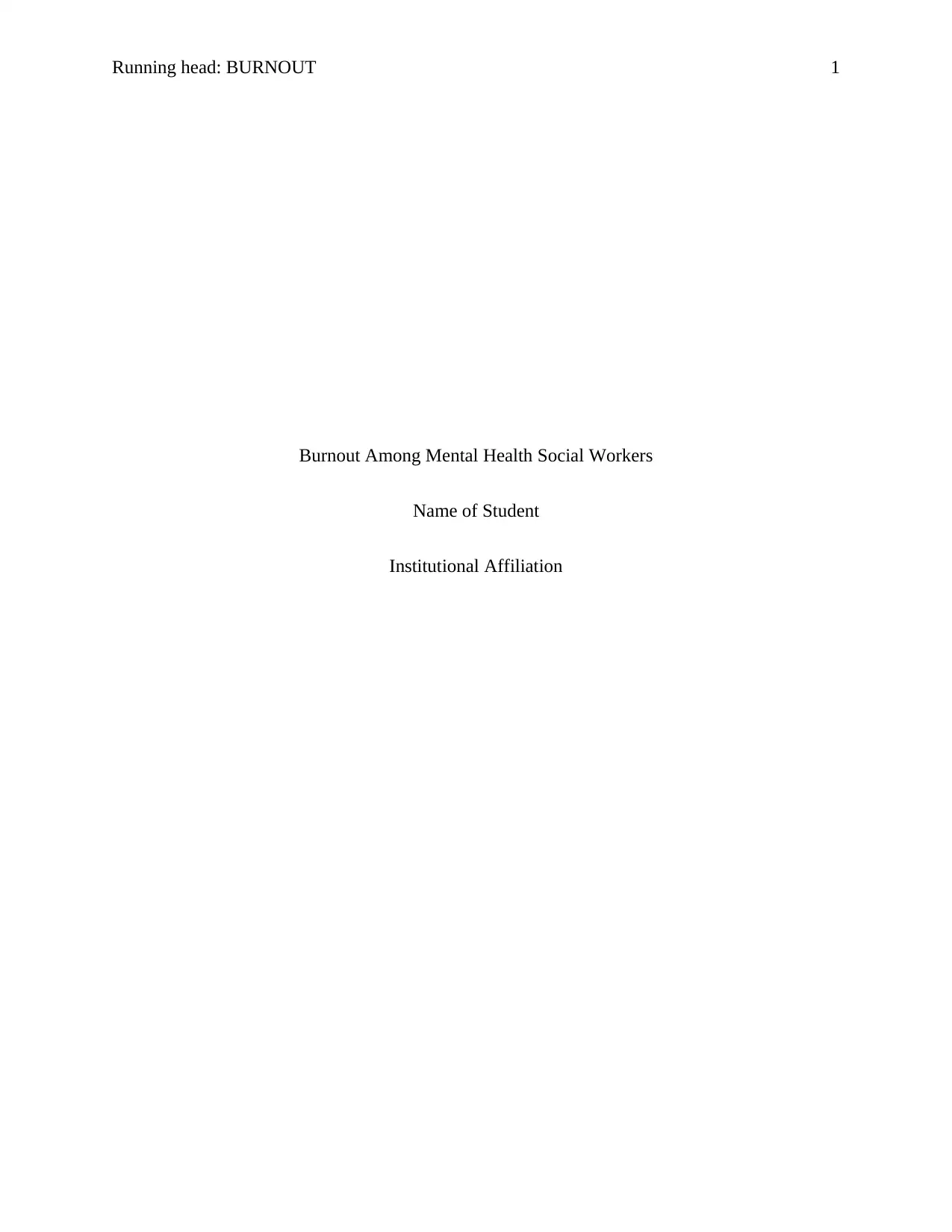
Running head: BURNOUT 1
Burnout Among Mental Health Social Workers
Name of Student
Institutional Affiliation
Burnout Among Mental Health Social Workers
Name of Student
Institutional Affiliation
Paraphrase This Document
Need a fresh take? Get an instant paraphrase of this document with our AI Paraphraser
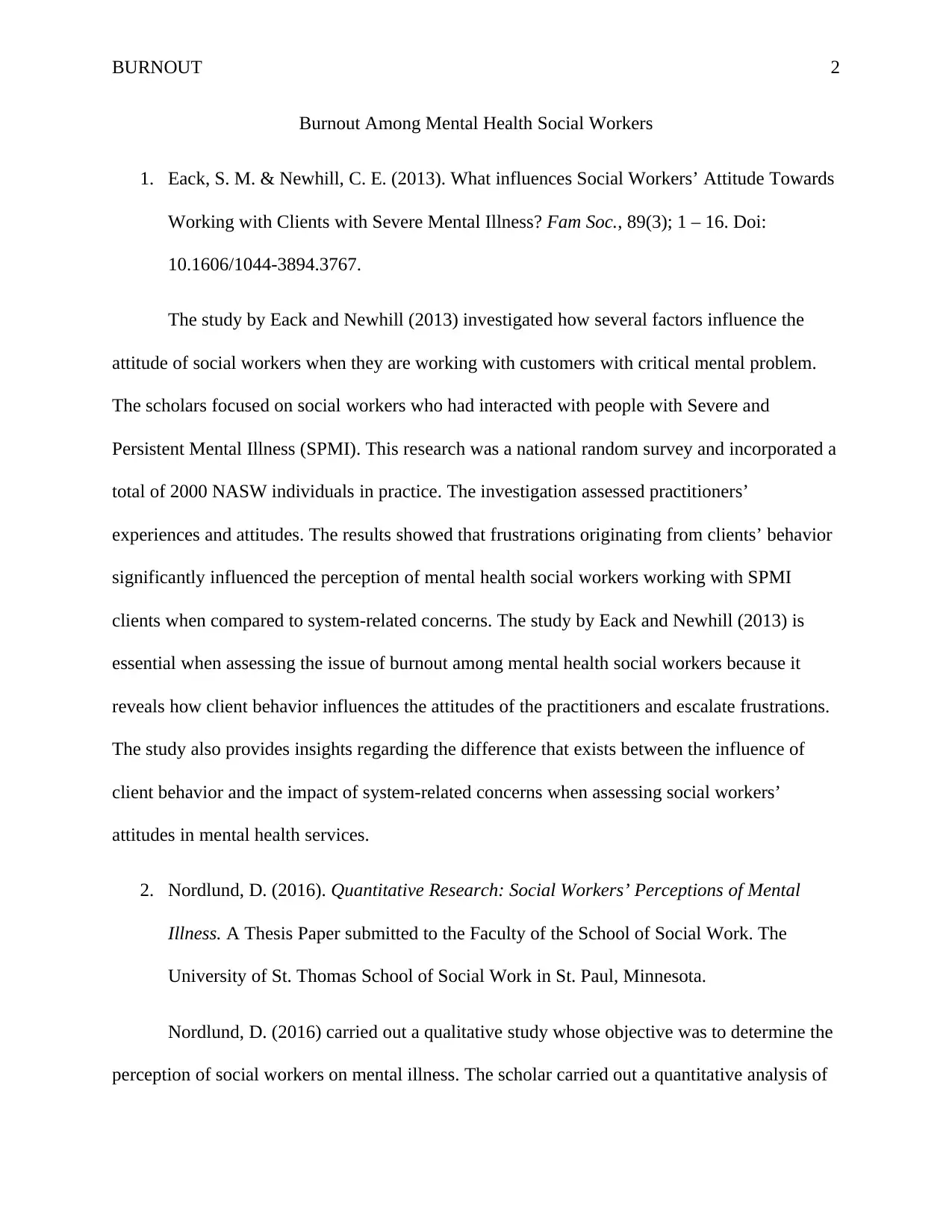
BURNOUT 2
Burnout Among Mental Health Social Workers
1. Eack, S. M. & Newhill, C. E. (2013). What influences Social Workers’ Attitude Towards
Working with Clients with Severe Mental Illness? Fam Soc., 89(3); 1 – 16. Doi:
10.1606/1044-3894.3767.
The study by Eack and Newhill (2013) investigated how several factors influence the
attitude of social workers when they are working with customers with critical mental problem.
The scholars focused on social workers who had interacted with people with Severe and
Persistent Mental Illness (SPMI). This research was a national random survey and incorporated a
total of 2000 NASW individuals in practice. The investigation assessed practitioners’
experiences and attitudes. The results showed that frustrations originating from clients’ behavior
significantly influenced the perception of mental health social workers working with SPMI
clients when compared to system-related concerns. The study by Eack and Newhill (2013) is
essential when assessing the issue of burnout among mental health social workers because it
reveals how client behavior influences the attitudes of the practitioners and escalate frustrations.
The study also provides insights regarding the difference that exists between the influence of
client behavior and the impact of system-related concerns when assessing social workers’
attitudes in mental health services.
2. Nordlund, D. (2016). Quantitative Research: Social Workers’ Perceptions of Mental
Illness. A Thesis Paper submitted to the Faculty of the School of Social Work. The
University of St. Thomas School of Social Work in St. Paul, Minnesota.
Nordlund, D. (2016) carried out a qualitative study whose objective was to determine the
perception of social workers on mental illness. The scholar carried out a quantitative analysis of
Burnout Among Mental Health Social Workers
1. Eack, S. M. & Newhill, C. E. (2013). What influences Social Workers’ Attitude Towards
Working with Clients with Severe Mental Illness? Fam Soc., 89(3); 1 – 16. Doi:
10.1606/1044-3894.3767.
The study by Eack and Newhill (2013) investigated how several factors influence the
attitude of social workers when they are working with customers with critical mental problem.
The scholars focused on social workers who had interacted with people with Severe and
Persistent Mental Illness (SPMI). This research was a national random survey and incorporated a
total of 2000 NASW individuals in practice. The investigation assessed practitioners’
experiences and attitudes. The results showed that frustrations originating from clients’ behavior
significantly influenced the perception of mental health social workers working with SPMI
clients when compared to system-related concerns. The study by Eack and Newhill (2013) is
essential when assessing the issue of burnout among mental health social workers because it
reveals how client behavior influences the attitudes of the practitioners and escalate frustrations.
The study also provides insights regarding the difference that exists between the influence of
client behavior and the impact of system-related concerns when assessing social workers’
attitudes in mental health services.
2. Nordlund, D. (2016). Quantitative Research: Social Workers’ Perceptions of Mental
Illness. A Thesis Paper submitted to the Faculty of the School of Social Work. The
University of St. Thomas School of Social Work in St. Paul, Minnesota.
Nordlund, D. (2016) carried out a qualitative study whose objective was to determine the
perception of social workers on mental illness. The scholar carried out a quantitative analysis of
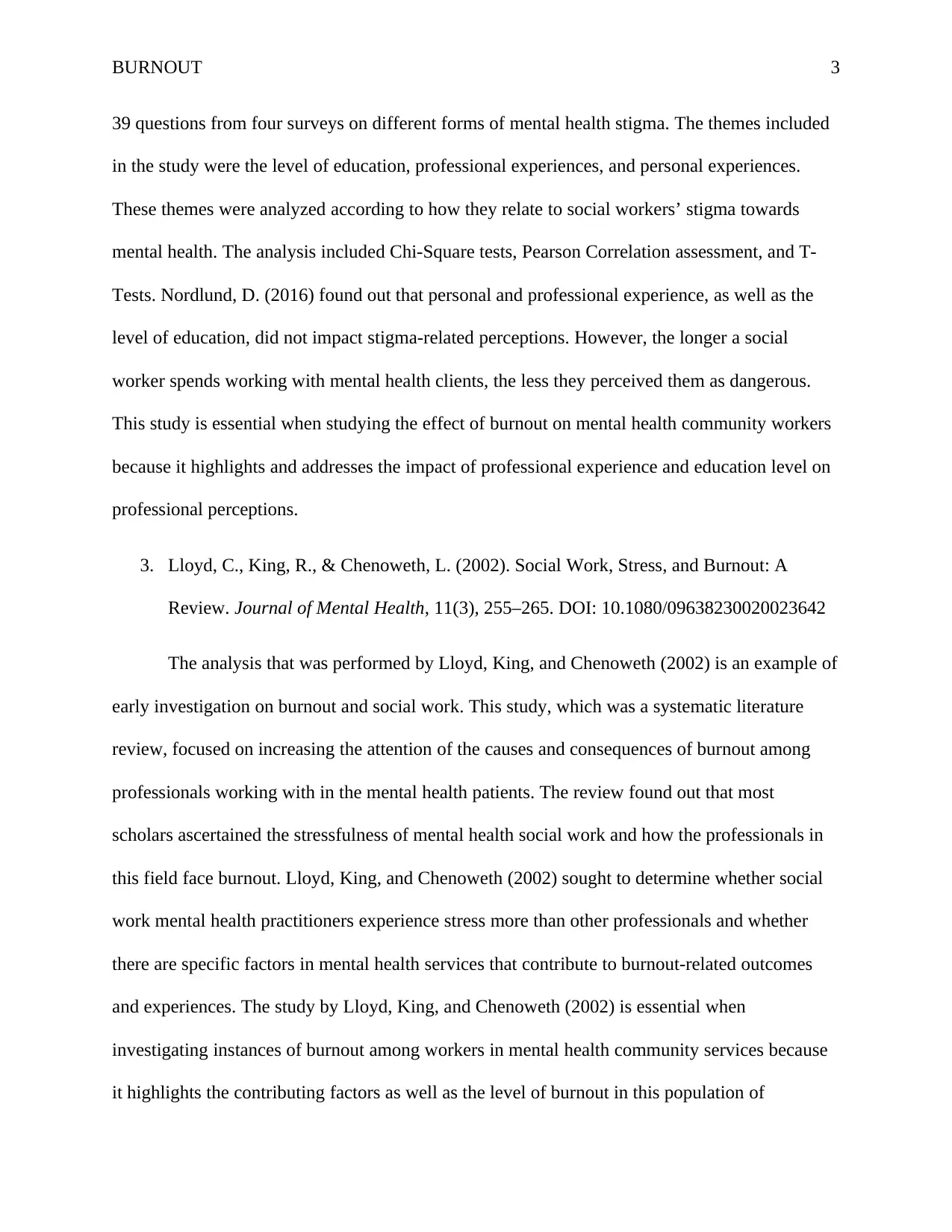
BURNOUT 3
39 questions from four surveys on different forms of mental health stigma. The themes included
in the study were the level of education, professional experiences, and personal experiences.
These themes were analyzed according to how they relate to social workers’ stigma towards
mental health. The analysis included Chi-Square tests, Pearson Correlation assessment, and T-
Tests. Nordlund, D. (2016) found out that personal and professional experience, as well as the
level of education, did not impact stigma-related perceptions. However, the longer a social
worker spends working with mental health clients, the less they perceived them as dangerous.
This study is essential when studying the effect of burnout on mental health community workers
because it highlights and addresses the impact of professional experience and education level on
professional perceptions.
3. Lloyd, C., King, R., & Chenoweth, L. (2002). Social Work, Stress, and Burnout: A
Review. Journal of Mental Health, 11(3), 255–265. DOI: 10.1080/09638230020023642
The analysis that was performed by Lloyd, King, and Chenoweth (2002) is an example of
early investigation on burnout and social work. This study, which was a systematic literature
review, focused on increasing the attention of the causes and consequences of burnout among
professionals working with in the mental health patients. The review found out that most
scholars ascertained the stressfulness of mental health social work and how the professionals in
this field face burnout. Lloyd, King, and Chenoweth (2002) sought to determine whether social
work mental health practitioners experience stress more than other professionals and whether
there are specific factors in mental health services that contribute to burnout-related outcomes
and experiences. The study by Lloyd, King, and Chenoweth (2002) is essential when
investigating instances of burnout among workers in mental health community services because
it highlights the contributing factors as well as the level of burnout in this population of
39 questions from four surveys on different forms of mental health stigma. The themes included
in the study were the level of education, professional experiences, and personal experiences.
These themes were analyzed according to how they relate to social workers’ stigma towards
mental health. The analysis included Chi-Square tests, Pearson Correlation assessment, and T-
Tests. Nordlund, D. (2016) found out that personal and professional experience, as well as the
level of education, did not impact stigma-related perceptions. However, the longer a social
worker spends working with mental health clients, the less they perceived them as dangerous.
This study is essential when studying the effect of burnout on mental health community workers
because it highlights and addresses the impact of professional experience and education level on
professional perceptions.
3. Lloyd, C., King, R., & Chenoweth, L. (2002). Social Work, Stress, and Burnout: A
Review. Journal of Mental Health, 11(3), 255–265. DOI: 10.1080/09638230020023642
The analysis that was performed by Lloyd, King, and Chenoweth (2002) is an example of
early investigation on burnout and social work. This study, which was a systematic literature
review, focused on increasing the attention of the causes and consequences of burnout among
professionals working with in the mental health patients. The review found out that most
scholars ascertained the stressfulness of mental health social work and how the professionals in
this field face burnout. Lloyd, King, and Chenoweth (2002) sought to determine whether social
work mental health practitioners experience stress more than other professionals and whether
there are specific factors in mental health services that contribute to burnout-related outcomes
and experiences. The study by Lloyd, King, and Chenoweth (2002) is essential when
investigating instances of burnout among workers in mental health community services because
it highlights the contributing factors as well as the level of burnout in this population of
⊘ This is a preview!⊘
Do you want full access?
Subscribe today to unlock all pages.

Trusted by 1+ million students worldwide
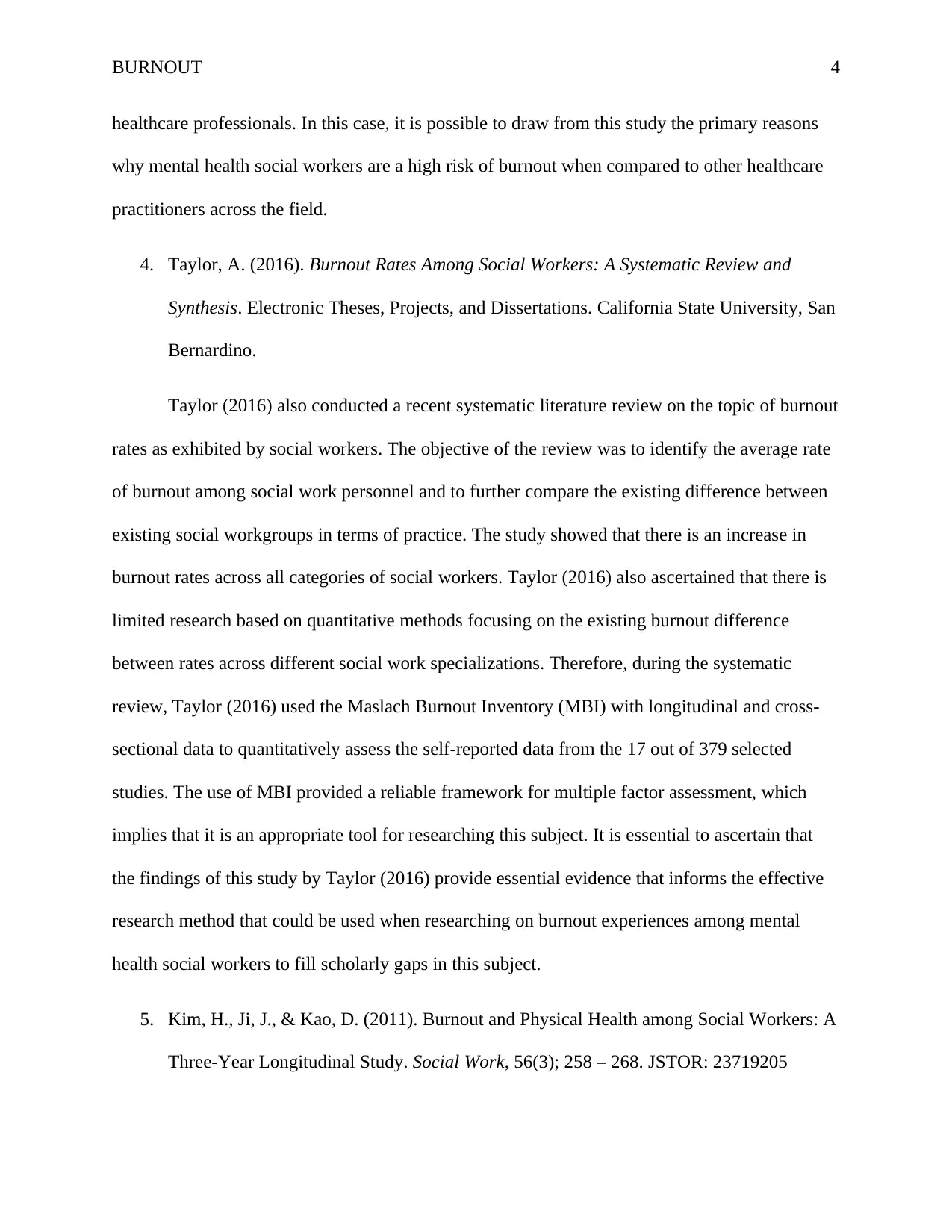
BURNOUT 4
healthcare professionals. In this case, it is possible to draw from this study the primary reasons
why mental health social workers are a high risk of burnout when compared to other healthcare
practitioners across the field.
4. Taylor, A. (2016). Burnout Rates Among Social Workers: A Systematic Review and
Synthesis. Electronic Theses, Projects, and Dissertations. California State University, San
Bernardino.
Taylor (2016) also conducted a recent systematic literature review on the topic of burnout
rates as exhibited by social workers. The objective of the review was to identify the average rate
of burnout among social work personnel and to further compare the existing difference between
existing social workgroups in terms of practice. The study showed that there is an increase in
burnout rates across all categories of social workers. Taylor (2016) also ascertained that there is
limited research based on quantitative methods focusing on the existing burnout difference
between rates across different social work specializations. Therefore, during the systematic
review, Taylor (2016) used the Maslach Burnout Inventory (MBI) with longitudinal and cross-
sectional data to quantitatively assess the self-reported data from the 17 out of 379 selected
studies. The use of MBI provided a reliable framework for multiple factor assessment, which
implies that it is an appropriate tool for researching this subject. It is essential to ascertain that
the findings of this study by Taylor (2016) provide essential evidence that informs the effective
research method that could be used when researching on burnout experiences among mental
health social workers to fill scholarly gaps in this subject.
5. Kim, H., Ji, J., & Kao, D. (2011). Burnout and Physical Health among Social Workers: A
Three-Year Longitudinal Study. Social Work, 56(3); 258 – 268. JSTOR: 23719205
healthcare professionals. In this case, it is possible to draw from this study the primary reasons
why mental health social workers are a high risk of burnout when compared to other healthcare
practitioners across the field.
4. Taylor, A. (2016). Burnout Rates Among Social Workers: A Systematic Review and
Synthesis. Electronic Theses, Projects, and Dissertations. California State University, San
Bernardino.
Taylor (2016) also conducted a recent systematic literature review on the topic of burnout
rates as exhibited by social workers. The objective of the review was to identify the average rate
of burnout among social work personnel and to further compare the existing difference between
existing social workgroups in terms of practice. The study showed that there is an increase in
burnout rates across all categories of social workers. Taylor (2016) also ascertained that there is
limited research based on quantitative methods focusing on the existing burnout difference
between rates across different social work specializations. Therefore, during the systematic
review, Taylor (2016) used the Maslach Burnout Inventory (MBI) with longitudinal and cross-
sectional data to quantitatively assess the self-reported data from the 17 out of 379 selected
studies. The use of MBI provided a reliable framework for multiple factor assessment, which
implies that it is an appropriate tool for researching this subject. It is essential to ascertain that
the findings of this study by Taylor (2016) provide essential evidence that informs the effective
research method that could be used when researching on burnout experiences among mental
health social workers to fill scholarly gaps in this subject.
5. Kim, H., Ji, J., & Kao, D. (2011). Burnout and Physical Health among Social Workers: A
Three-Year Longitudinal Study. Social Work, 56(3); 258 – 268. JSTOR: 23719205
Paraphrase This Document
Need a fresh take? Get an instant paraphrase of this document with our AI Paraphraser
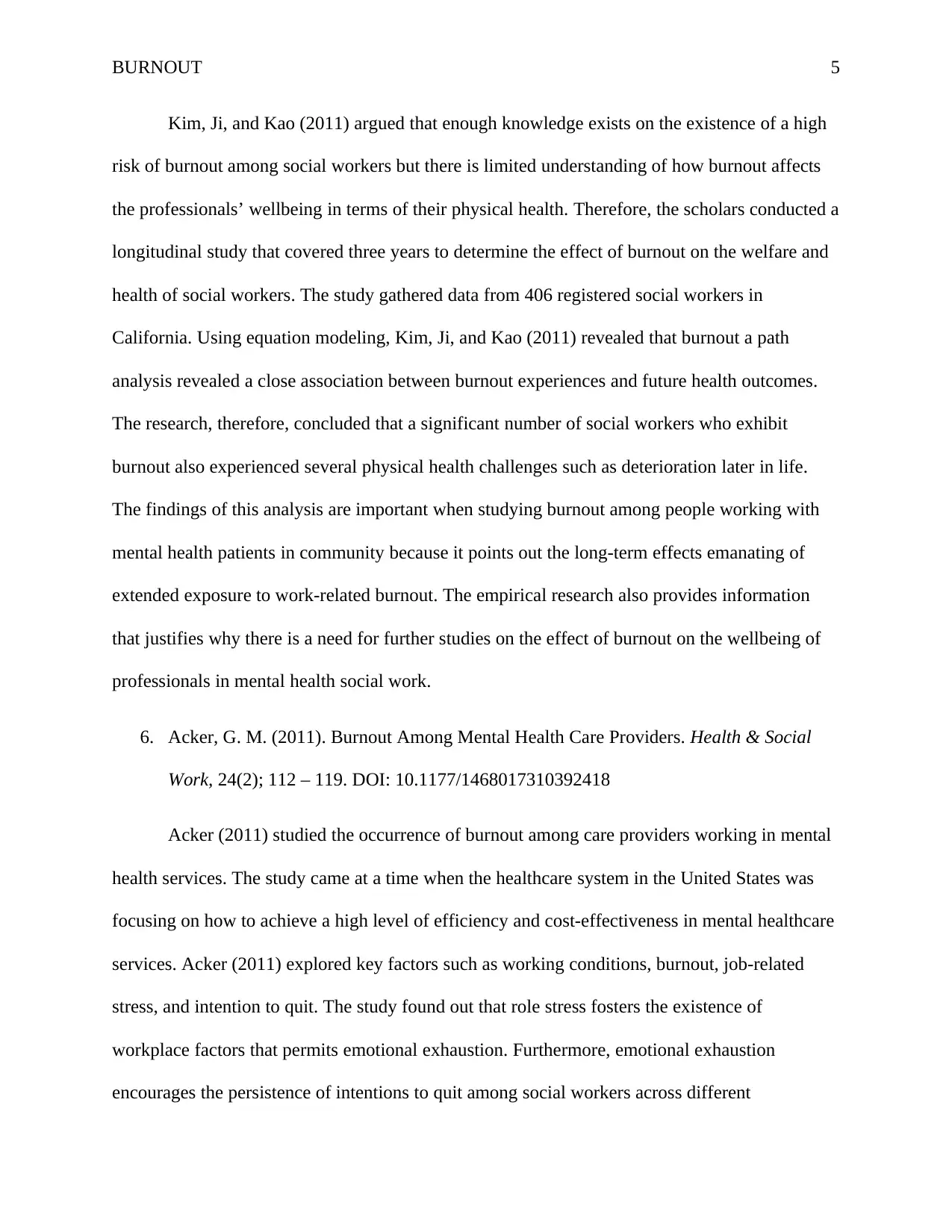
BURNOUT 5
Kim, Ji, and Kao (2011) argued that enough knowledge exists on the existence of a high
risk of burnout among social workers but there is limited understanding of how burnout affects
the professionals’ wellbeing in terms of their physical health. Therefore, the scholars conducted a
longitudinal study that covered three years to determine the effect of burnout on the welfare and
health of social workers. The study gathered data from 406 registered social workers in
California. Using equation modeling, Kim, Ji, and Kao (2011) revealed that burnout a path
analysis revealed a close association between burnout experiences and future health outcomes.
The research, therefore, concluded that a significant number of social workers who exhibit
burnout also experienced several physical health challenges such as deterioration later in life.
The findings of this analysis are important when studying burnout among people working with
mental health patients in community because it points out the long-term effects emanating of
extended exposure to work-related burnout. The empirical research also provides information
that justifies why there is a need for further studies on the effect of burnout on the wellbeing of
professionals in mental health social work.
6. Acker, G. M. (2011). Burnout Among Mental Health Care Providers. Health & Social
Work, 24(2); 112 – 119. DOI: 10.1177/1468017310392418
Acker (2011) studied the occurrence of burnout among care providers working in mental
health services. The study came at a time when the healthcare system in the United States was
focusing on how to achieve a high level of efficiency and cost-effectiveness in mental healthcare
services. Acker (2011) explored key factors such as working conditions, burnout, job-related
stress, and intention to quit. The study found out that role stress fosters the existence of
workplace factors that permits emotional exhaustion. Furthermore, emotional exhaustion
encourages the persistence of intentions to quit among social workers across different
Kim, Ji, and Kao (2011) argued that enough knowledge exists on the existence of a high
risk of burnout among social workers but there is limited understanding of how burnout affects
the professionals’ wellbeing in terms of their physical health. Therefore, the scholars conducted a
longitudinal study that covered three years to determine the effect of burnout on the welfare and
health of social workers. The study gathered data from 406 registered social workers in
California. Using equation modeling, Kim, Ji, and Kao (2011) revealed that burnout a path
analysis revealed a close association between burnout experiences and future health outcomes.
The research, therefore, concluded that a significant number of social workers who exhibit
burnout also experienced several physical health challenges such as deterioration later in life.
The findings of this analysis are important when studying burnout among people working with
mental health patients in community because it points out the long-term effects emanating of
extended exposure to work-related burnout. The empirical research also provides information
that justifies why there is a need for further studies on the effect of burnout on the wellbeing of
professionals in mental health social work.
6. Acker, G. M. (2011). Burnout Among Mental Health Care Providers. Health & Social
Work, 24(2); 112 – 119. DOI: 10.1177/1468017310392418
Acker (2011) studied the occurrence of burnout among care providers working in mental
health services. The study came at a time when the healthcare system in the United States was
focusing on how to achieve a high level of efficiency and cost-effectiveness in mental healthcare
services. Acker (2011) explored key factors such as working conditions, burnout, job-related
stress, and intention to quit. The study found out that role stress fosters the existence of
workplace factors that permits emotional exhaustion. Furthermore, emotional exhaustion
encourages the persistence of intentions to quit among social workers across different
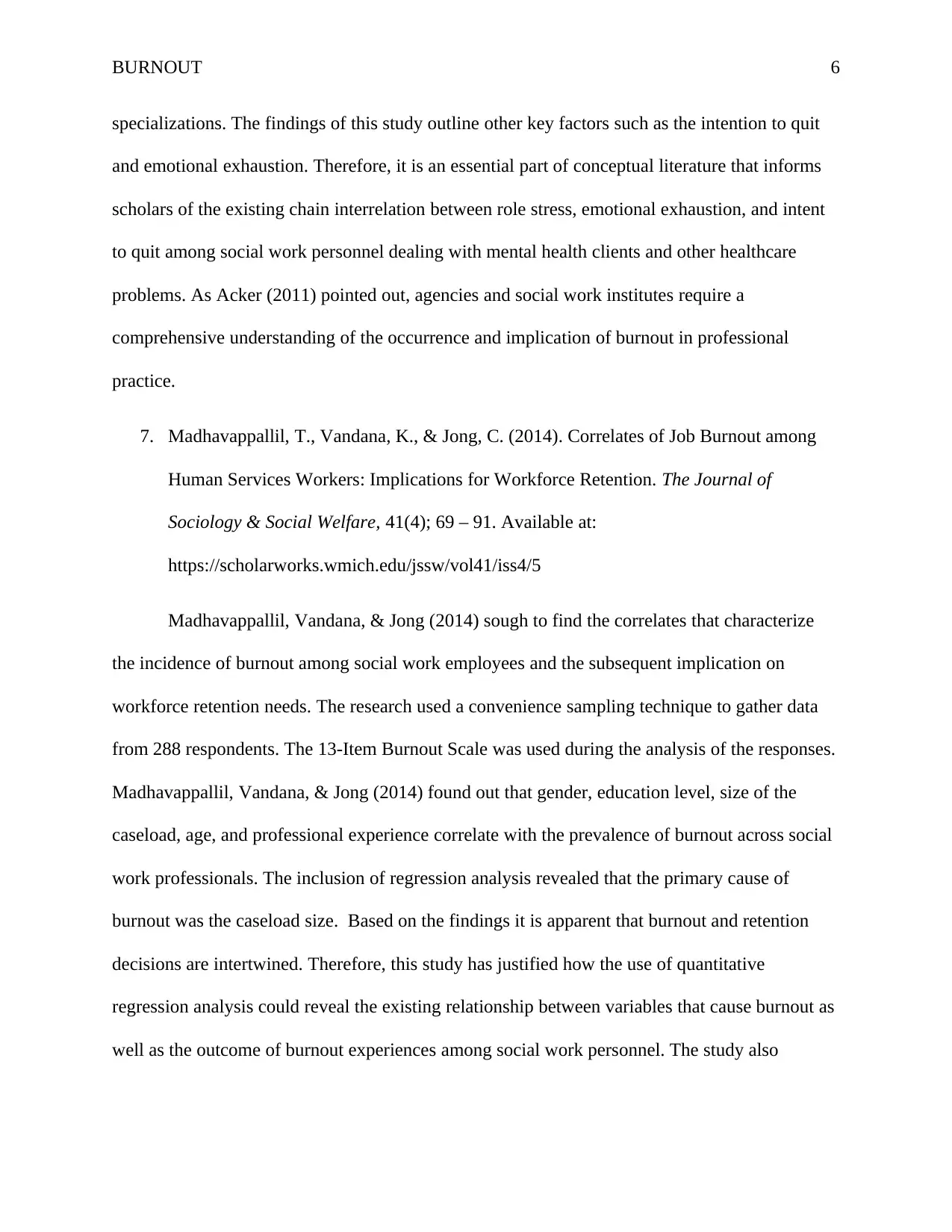
BURNOUT 6
specializations. The findings of this study outline other key factors such as the intention to quit
and emotional exhaustion. Therefore, it is an essential part of conceptual literature that informs
scholars of the existing chain interrelation between role stress, emotional exhaustion, and intent
to quit among social work personnel dealing with mental health clients and other healthcare
problems. As Acker (2011) pointed out, agencies and social work institutes require a
comprehensive understanding of the occurrence and implication of burnout in professional
practice.
7. Madhavappallil, T., Vandana, K., & Jong, C. (2014). Correlates of Job Burnout among
Human Services Workers: Implications for Workforce Retention. The Journal of
Sociology & Social Welfare, 41(4); 69 – 91. Available at:
https://scholarworks.wmich.edu/jssw/vol41/iss4/5
Madhavappallil, Vandana, & Jong (2014) sough to find the correlates that characterize
the incidence of burnout among social work employees and the subsequent implication on
workforce retention needs. The research used a convenience sampling technique to gather data
from 288 respondents. The 13-Item Burnout Scale was used during the analysis of the responses.
Madhavappallil, Vandana, & Jong (2014) found out that gender, education level, size of the
caseload, age, and professional experience correlate with the prevalence of burnout across social
work professionals. The inclusion of regression analysis revealed that the primary cause of
burnout was the caseload size. Based on the findings it is apparent that burnout and retention
decisions are intertwined. Therefore, this study has justified how the use of quantitative
regression analysis could reveal the existing relationship between variables that cause burnout as
well as the outcome of burnout experiences among social work personnel. The study also
specializations. The findings of this study outline other key factors such as the intention to quit
and emotional exhaustion. Therefore, it is an essential part of conceptual literature that informs
scholars of the existing chain interrelation between role stress, emotional exhaustion, and intent
to quit among social work personnel dealing with mental health clients and other healthcare
problems. As Acker (2011) pointed out, agencies and social work institutes require a
comprehensive understanding of the occurrence and implication of burnout in professional
practice.
7. Madhavappallil, T., Vandana, K., & Jong, C. (2014). Correlates of Job Burnout among
Human Services Workers: Implications for Workforce Retention. The Journal of
Sociology & Social Welfare, 41(4); 69 – 91. Available at:
https://scholarworks.wmich.edu/jssw/vol41/iss4/5
Madhavappallil, Vandana, & Jong (2014) sough to find the correlates that characterize
the incidence of burnout among social work employees and the subsequent implication on
workforce retention needs. The research used a convenience sampling technique to gather data
from 288 respondents. The 13-Item Burnout Scale was used during the analysis of the responses.
Madhavappallil, Vandana, & Jong (2014) found out that gender, education level, size of the
caseload, age, and professional experience correlate with the prevalence of burnout across social
work professionals. The inclusion of regression analysis revealed that the primary cause of
burnout was the caseload size. Based on the findings it is apparent that burnout and retention
decisions are intertwined. Therefore, this study has justified how the use of quantitative
regression analysis could reveal the existing relationship between variables that cause burnout as
well as the outcome of burnout experiences among social work personnel. The study also
⊘ This is a preview!⊘
Do you want full access?
Subscribe today to unlock all pages.

Trusted by 1+ million students worldwide
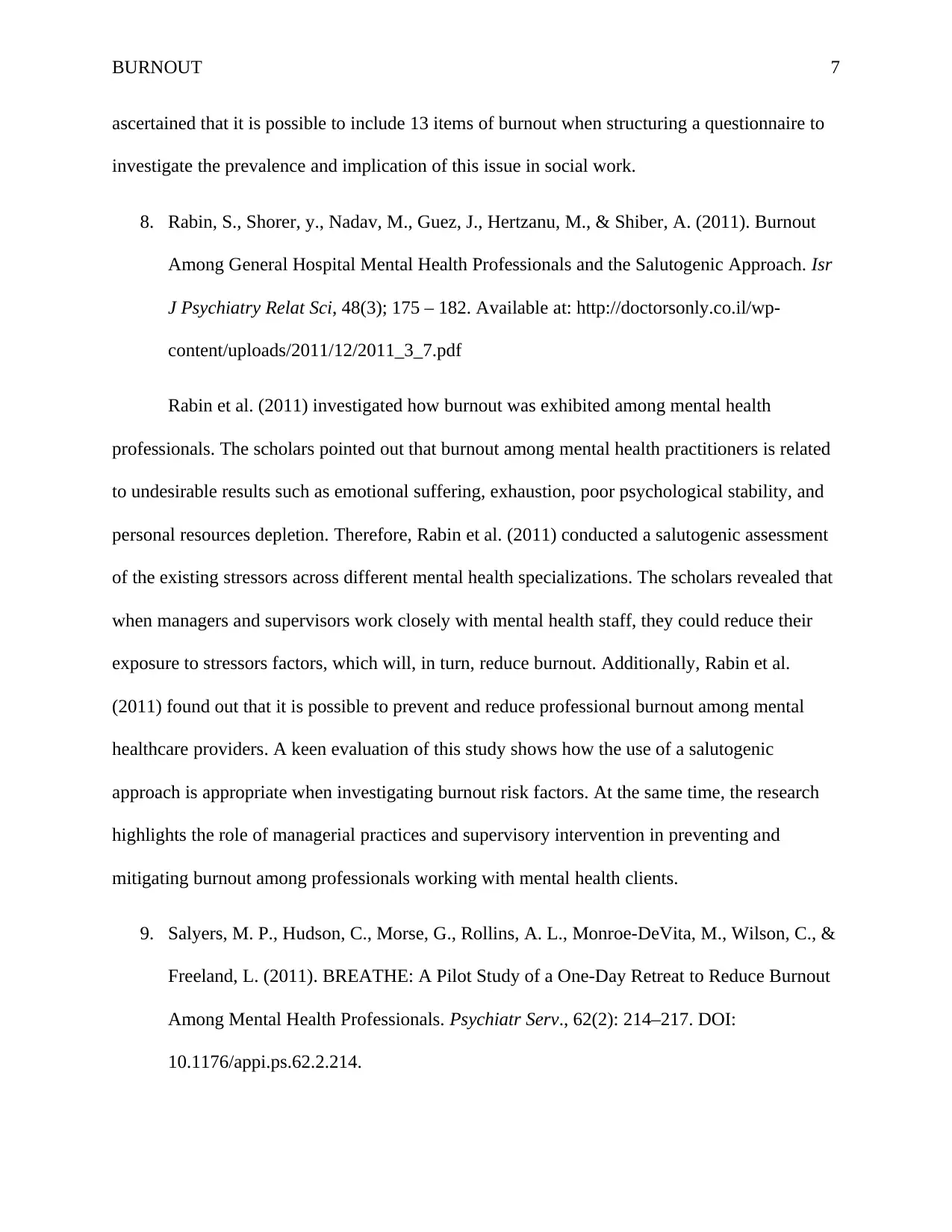
BURNOUT 7
ascertained that it is possible to include 13 items of burnout when structuring a questionnaire to
investigate the prevalence and implication of this issue in social work.
8. Rabin, S., Shorer, y., Nadav, M., Guez, J., Hertzanu, M., & Shiber, A. (2011). Burnout
Among General Hospital Mental Health Professionals and the Salutogenic Approach. Isr
J Psychiatry Relat Sci, 48(3); 175 – 182. Available at: http://doctorsonly.co.il/wp-
content/uploads/2011/12/2011_3_7.pdf
Rabin et al. (2011) investigated how burnout was exhibited among mental health
professionals. The scholars pointed out that burnout among mental health practitioners is related
to undesirable results such as emotional suffering, exhaustion, poor psychological stability, and
personal resources depletion. Therefore, Rabin et al. (2011) conducted a salutogenic assessment
of the existing stressors across different mental health specializations. The scholars revealed that
when managers and supervisors work closely with mental health staff, they could reduce their
exposure to stressors factors, which will, in turn, reduce burnout. Additionally, Rabin et al.
(2011) found out that it is possible to prevent and reduce professional burnout among mental
healthcare providers. A keen evaluation of this study shows how the use of a salutogenic
approach is appropriate when investigating burnout risk factors. At the same time, the research
highlights the role of managerial practices and supervisory intervention in preventing and
mitigating burnout among professionals working with mental health clients.
9. Salyers, M. P., Hudson, C., Morse, G., Rollins, A. L., Monroe-DeVita, M., Wilson, C., &
Freeland, L. (2011). BREATHE: A Pilot Study of a One-Day Retreat to Reduce Burnout
Among Mental Health Professionals. Psychiatr Serv., 62(2): 214–217. DOI:
10.1176/appi.ps.62.2.214.
ascertained that it is possible to include 13 items of burnout when structuring a questionnaire to
investigate the prevalence and implication of this issue in social work.
8. Rabin, S., Shorer, y., Nadav, M., Guez, J., Hertzanu, M., & Shiber, A. (2011). Burnout
Among General Hospital Mental Health Professionals and the Salutogenic Approach. Isr
J Psychiatry Relat Sci, 48(3); 175 – 182. Available at: http://doctorsonly.co.il/wp-
content/uploads/2011/12/2011_3_7.pdf
Rabin et al. (2011) investigated how burnout was exhibited among mental health
professionals. The scholars pointed out that burnout among mental health practitioners is related
to undesirable results such as emotional suffering, exhaustion, poor psychological stability, and
personal resources depletion. Therefore, Rabin et al. (2011) conducted a salutogenic assessment
of the existing stressors across different mental health specializations. The scholars revealed that
when managers and supervisors work closely with mental health staff, they could reduce their
exposure to stressors factors, which will, in turn, reduce burnout. Additionally, Rabin et al.
(2011) found out that it is possible to prevent and reduce professional burnout among mental
healthcare providers. A keen evaluation of this study shows how the use of a salutogenic
approach is appropriate when investigating burnout risk factors. At the same time, the research
highlights the role of managerial practices and supervisory intervention in preventing and
mitigating burnout among professionals working with mental health clients.
9. Salyers, M. P., Hudson, C., Morse, G., Rollins, A. L., Monroe-DeVita, M., Wilson, C., &
Freeland, L. (2011). BREATHE: A Pilot Study of a One-Day Retreat to Reduce Burnout
Among Mental Health Professionals. Psychiatr Serv., 62(2): 214–217. DOI:
10.1176/appi.ps.62.2.214.
Paraphrase This Document
Need a fresh take? Get an instant paraphrase of this document with our AI Paraphraser
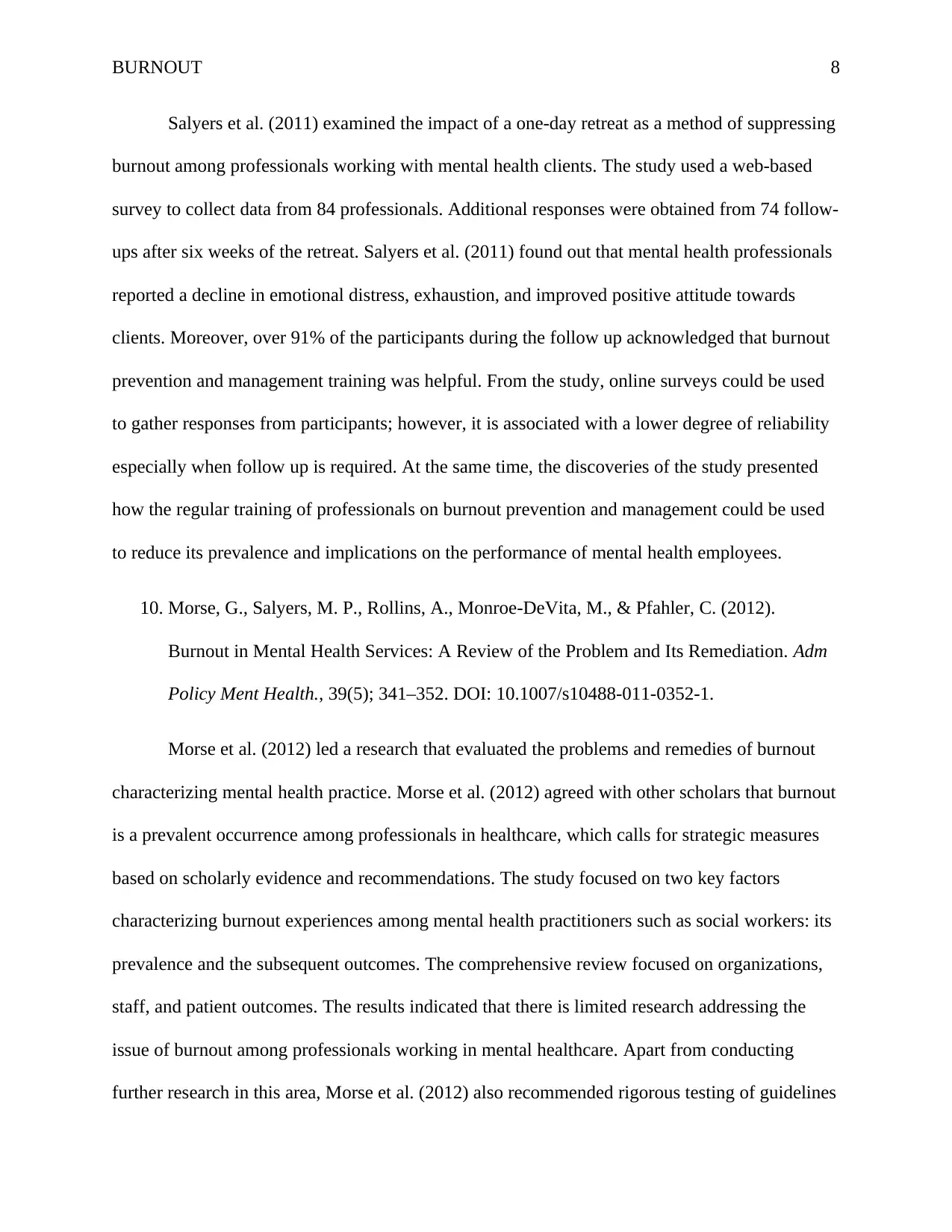
BURNOUT 8
Salyers et al. (2011) examined the impact of a one-day retreat as a method of suppressing
burnout among professionals working with mental health clients. The study used a web-based
survey to collect data from 84 professionals. Additional responses were obtained from 74 follow-
ups after six weeks of the retreat. Salyers et al. (2011) found out that mental health professionals
reported a decline in emotional distress, exhaustion, and improved positive attitude towards
clients. Moreover, over 91% of the participants during the follow up acknowledged that burnout
prevention and management training was helpful. From the study, online surveys could be used
to gather responses from participants; however, it is associated with a lower degree of reliability
especially when follow up is required. At the same time, the discoveries of the study presented
how the regular training of professionals on burnout prevention and management could be used
to reduce its prevalence and implications on the performance of mental health employees.
10. Morse, G., Salyers, M. P., Rollins, A., Monroe-DeVita, M., & Pfahler, C. (2012).
Burnout in Mental Health Services: A Review of the Problem and Its Remediation. Adm
Policy Ment Health., 39(5); 341–352. DOI: 10.1007/s10488-011-0352-1.
Morse et al. (2012) led a research that evaluated the problems and remedies of burnout
characterizing mental health practice. Morse et al. (2012) agreed with other scholars that burnout
is a prevalent occurrence among professionals in healthcare, which calls for strategic measures
based on scholarly evidence and recommendations. The study focused on two key factors
characterizing burnout experiences among mental health practitioners such as social workers: its
prevalence and the subsequent outcomes. The comprehensive review focused on organizations,
staff, and patient outcomes. The results indicated that there is limited research addressing the
issue of burnout among professionals working in mental healthcare. Apart from conducting
further research in this area, Morse et al. (2012) also recommended rigorous testing of guidelines
Salyers et al. (2011) examined the impact of a one-day retreat as a method of suppressing
burnout among professionals working with mental health clients. The study used a web-based
survey to collect data from 84 professionals. Additional responses were obtained from 74 follow-
ups after six weeks of the retreat. Salyers et al. (2011) found out that mental health professionals
reported a decline in emotional distress, exhaustion, and improved positive attitude towards
clients. Moreover, over 91% of the participants during the follow up acknowledged that burnout
prevention and management training was helpful. From the study, online surveys could be used
to gather responses from participants; however, it is associated with a lower degree of reliability
especially when follow up is required. At the same time, the discoveries of the study presented
how the regular training of professionals on burnout prevention and management could be used
to reduce its prevalence and implications on the performance of mental health employees.
10. Morse, G., Salyers, M. P., Rollins, A., Monroe-DeVita, M., & Pfahler, C. (2012).
Burnout in Mental Health Services: A Review of the Problem and Its Remediation. Adm
Policy Ment Health., 39(5); 341–352. DOI: 10.1007/s10488-011-0352-1.
Morse et al. (2012) led a research that evaluated the problems and remedies of burnout
characterizing mental health practice. Morse et al. (2012) agreed with other scholars that burnout
is a prevalent occurrence among professionals in healthcare, which calls for strategic measures
based on scholarly evidence and recommendations. The study focused on two key factors
characterizing burnout experiences among mental health practitioners such as social workers: its
prevalence and the subsequent outcomes. The comprehensive review focused on organizations,
staff, and patient outcomes. The results indicated that there is limited research addressing the
issue of burnout among professionals working in mental healthcare. Apart from conducting
further research in this area, Morse et al. (2012) also recommended rigorous testing of guidelines
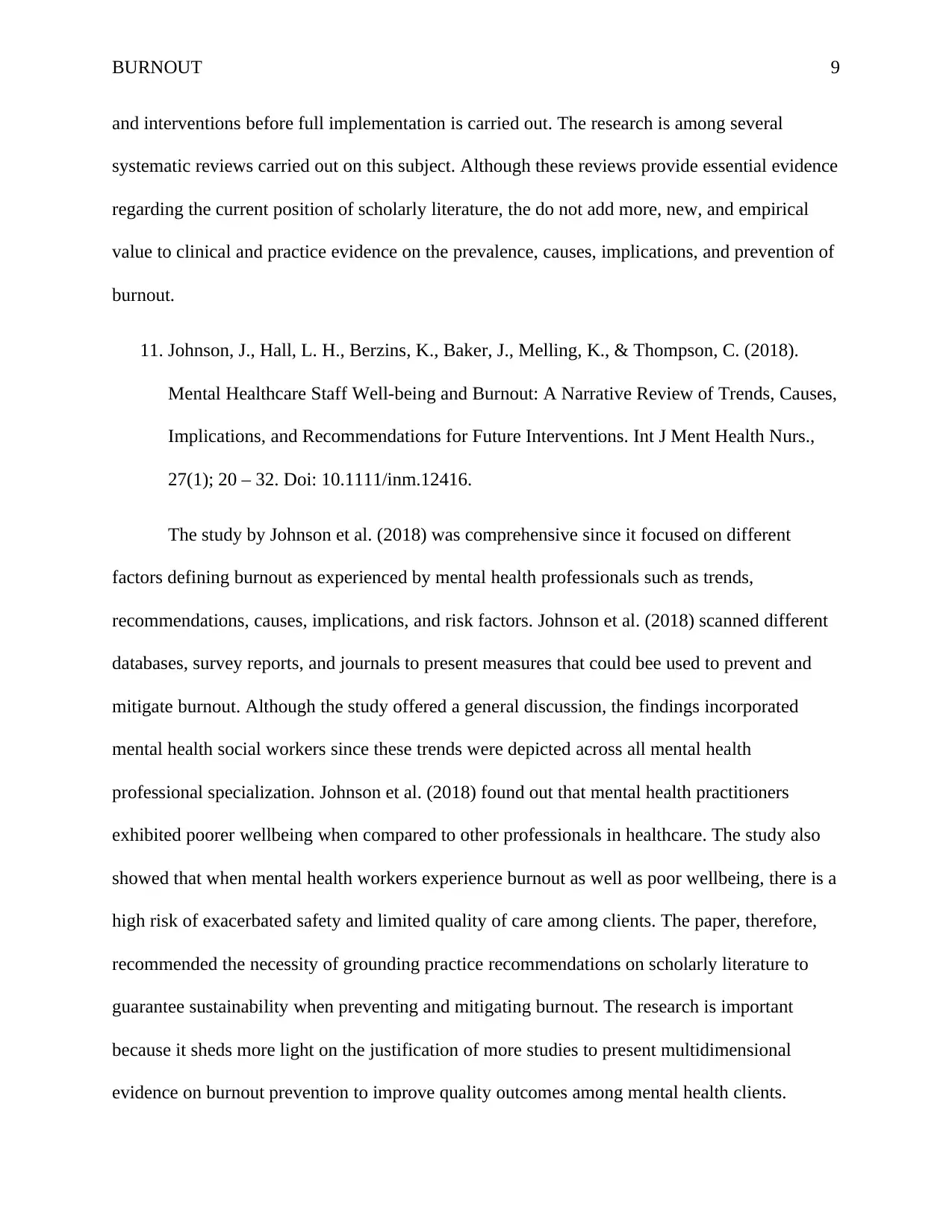
BURNOUT 9
and interventions before full implementation is carried out. The research is among several
systematic reviews carried out on this subject. Although these reviews provide essential evidence
regarding the current position of scholarly literature, the do not add more, new, and empirical
value to clinical and practice evidence on the prevalence, causes, implications, and prevention of
burnout.
11. Johnson, J., Hall, L. H., Berzins, K., Baker, J., Melling, K., & Thompson, C. (2018).
Mental Healthcare Staff Well-being and Burnout: A Narrative Review of Trends, Causes,
Implications, and Recommendations for Future Interventions. Int J Ment Health Nurs.,
27(1); 20 – 32. Doi: 10.1111/inm.12416.
The study by Johnson et al. (2018) was comprehensive since it focused on different
factors defining burnout as experienced by mental health professionals such as trends,
recommendations, causes, implications, and risk factors. Johnson et al. (2018) scanned different
databases, survey reports, and journals to present measures that could bee used to prevent and
mitigate burnout. Although the study offered a general discussion, the findings incorporated
mental health social workers since these trends were depicted across all mental health
professional specialization. Johnson et al. (2018) found out that mental health practitioners
exhibited poorer wellbeing when compared to other professionals in healthcare. The study also
showed that when mental health workers experience burnout as well as poor wellbeing, there is a
high risk of exacerbated safety and limited quality of care among clients. The paper, therefore,
recommended the necessity of grounding practice recommendations on scholarly literature to
guarantee sustainability when preventing and mitigating burnout. The research is important
because it sheds more light on the justification of more studies to present multidimensional
evidence on burnout prevention to improve quality outcomes among mental health clients.
and interventions before full implementation is carried out. The research is among several
systematic reviews carried out on this subject. Although these reviews provide essential evidence
regarding the current position of scholarly literature, the do not add more, new, and empirical
value to clinical and practice evidence on the prevalence, causes, implications, and prevention of
burnout.
11. Johnson, J., Hall, L. H., Berzins, K., Baker, J., Melling, K., & Thompson, C. (2018).
Mental Healthcare Staff Well-being and Burnout: A Narrative Review of Trends, Causes,
Implications, and Recommendations for Future Interventions. Int J Ment Health Nurs.,
27(1); 20 – 32. Doi: 10.1111/inm.12416.
The study by Johnson et al. (2018) was comprehensive since it focused on different
factors defining burnout as experienced by mental health professionals such as trends,
recommendations, causes, implications, and risk factors. Johnson et al. (2018) scanned different
databases, survey reports, and journals to present measures that could bee used to prevent and
mitigate burnout. Although the study offered a general discussion, the findings incorporated
mental health social workers since these trends were depicted across all mental health
professional specialization. Johnson et al. (2018) found out that mental health practitioners
exhibited poorer wellbeing when compared to other professionals in healthcare. The study also
showed that when mental health workers experience burnout as well as poor wellbeing, there is a
high risk of exacerbated safety and limited quality of care among clients. The paper, therefore,
recommended the necessity of grounding practice recommendations on scholarly literature to
guarantee sustainability when preventing and mitigating burnout. The research is important
because it sheds more light on the justification of more studies to present multidimensional
evidence on burnout prevention to improve quality outcomes among mental health clients.
⊘ This is a preview!⊘
Do you want full access?
Subscribe today to unlock all pages.

Trusted by 1+ million students worldwide
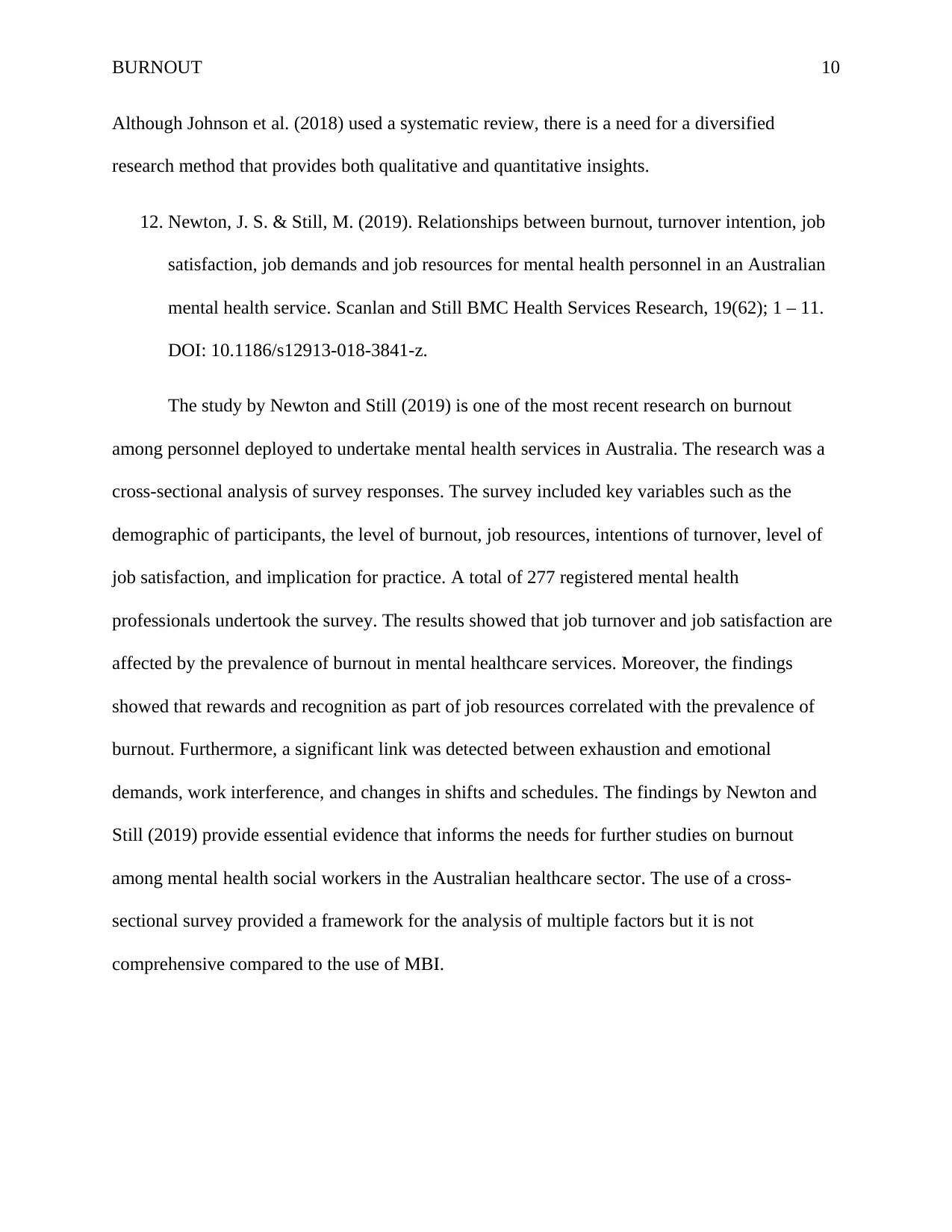
BURNOUT 10
Although Johnson et al. (2018) used a systematic review, there is a need for a diversified
research method that provides both qualitative and quantitative insights.
12. Newton, J. S. & Still, M. (2019). Relationships between burnout, turnover intention, job
satisfaction, job demands and job resources for mental health personnel in an Australian
mental health service. Scanlan and Still BMC Health Services Research, 19(62); 1 – 11.
DOI: 10.1186/s12913-018-3841-z.
The study by Newton and Still (2019) is one of the most recent research on burnout
among personnel deployed to undertake mental health services in Australia. The research was a
cross-sectional analysis of survey responses. The survey included key variables such as the
demographic of participants, the level of burnout, job resources, intentions of turnover, level of
job satisfaction, and implication for practice. A total of 277 registered mental health
professionals undertook the survey. The results showed that job turnover and job satisfaction are
affected by the prevalence of burnout in mental healthcare services. Moreover, the findings
showed that rewards and recognition as part of job resources correlated with the prevalence of
burnout. Furthermore, a significant link was detected between exhaustion and emotional
demands, work interference, and changes in shifts and schedules. The findings by Newton and
Still (2019) provide essential evidence that informs the needs for further studies on burnout
among mental health social workers in the Australian healthcare sector. The use of a cross-
sectional survey provided a framework for the analysis of multiple factors but it is not
comprehensive compared to the use of MBI.
Although Johnson et al. (2018) used a systematic review, there is a need for a diversified
research method that provides both qualitative and quantitative insights.
12. Newton, J. S. & Still, M. (2019). Relationships between burnout, turnover intention, job
satisfaction, job demands and job resources for mental health personnel in an Australian
mental health service. Scanlan and Still BMC Health Services Research, 19(62); 1 – 11.
DOI: 10.1186/s12913-018-3841-z.
The study by Newton and Still (2019) is one of the most recent research on burnout
among personnel deployed to undertake mental health services in Australia. The research was a
cross-sectional analysis of survey responses. The survey included key variables such as the
demographic of participants, the level of burnout, job resources, intentions of turnover, level of
job satisfaction, and implication for practice. A total of 277 registered mental health
professionals undertook the survey. The results showed that job turnover and job satisfaction are
affected by the prevalence of burnout in mental healthcare services. Moreover, the findings
showed that rewards and recognition as part of job resources correlated with the prevalence of
burnout. Furthermore, a significant link was detected between exhaustion and emotional
demands, work interference, and changes in shifts and schedules. The findings by Newton and
Still (2019) provide essential evidence that informs the needs for further studies on burnout
among mental health social workers in the Australian healthcare sector. The use of a cross-
sectional survey provided a framework for the analysis of multiple factors but it is not
comprehensive compared to the use of MBI.
Paraphrase This Document
Need a fresh take? Get an instant paraphrase of this document with our AI Paraphraser
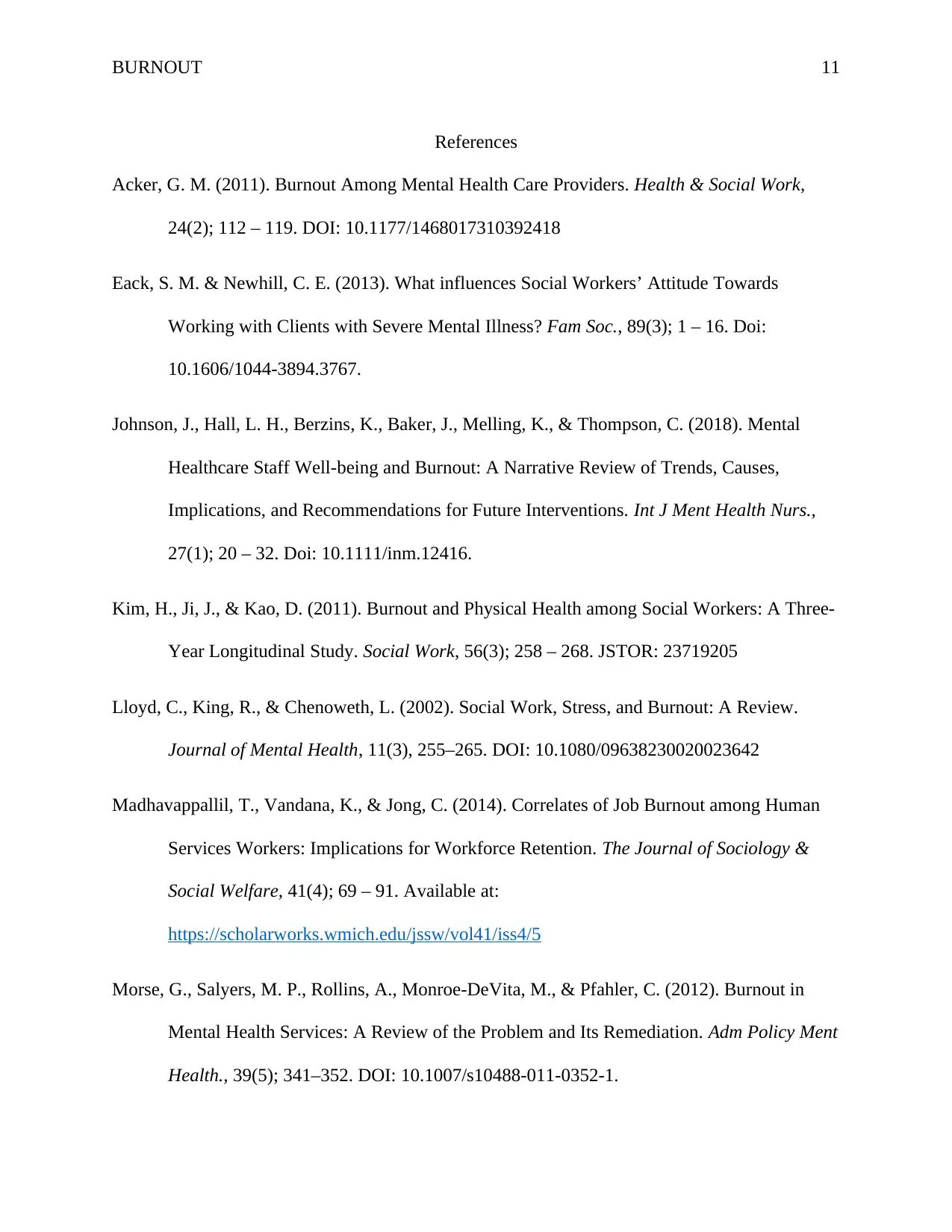
BURNOUT 11
References
Acker, G. M. (2011). Burnout Among Mental Health Care Providers. Health & Social Work,
24(2); 112 – 119. DOI: 10.1177/1468017310392418
Eack, S. M. & Newhill, C. E. (2013). What influences Social Workers’ Attitude Towards
Working with Clients with Severe Mental Illness? Fam Soc., 89(3); 1 – 16. Doi:
10.1606/1044-3894.3767.
Johnson, J., Hall, L. H., Berzins, K., Baker, J., Melling, K., & Thompson, C. (2018). Mental
Healthcare Staff Well-being and Burnout: A Narrative Review of Trends, Causes,
Implications, and Recommendations for Future Interventions. Int J Ment Health Nurs.,
27(1); 20 – 32. Doi: 10.1111/inm.12416.
Kim, H., Ji, J., & Kao, D. (2011). Burnout and Physical Health among Social Workers: A Three-
Year Longitudinal Study. Social Work, 56(3); 258 – 268. JSTOR: 23719205
Lloyd, C., King, R., & Chenoweth, L. (2002). Social Work, Stress, and Burnout: A Review.
Journal of Mental Health, 11(3), 255–265. DOI: 10.1080/09638230020023642
Madhavappallil, T., Vandana, K., & Jong, C. (2014). Correlates of Job Burnout among Human
Services Workers: Implications for Workforce Retention. The Journal of Sociology &
Social Welfare, 41(4); 69 – 91. Available at:
https://scholarworks.wmich.edu/jssw/vol41/iss4/5
Morse, G., Salyers, M. P., Rollins, A., Monroe-DeVita, M., & Pfahler, C. (2012). Burnout in
Mental Health Services: A Review of the Problem and Its Remediation. Adm Policy Ment
Health., 39(5); 341–352. DOI: 10.1007/s10488-011-0352-1.
References
Acker, G. M. (2011). Burnout Among Mental Health Care Providers. Health & Social Work,
24(2); 112 – 119. DOI: 10.1177/1468017310392418
Eack, S. M. & Newhill, C. E. (2013). What influences Social Workers’ Attitude Towards
Working with Clients with Severe Mental Illness? Fam Soc., 89(3); 1 – 16. Doi:
10.1606/1044-3894.3767.
Johnson, J., Hall, L. H., Berzins, K., Baker, J., Melling, K., & Thompson, C. (2018). Mental
Healthcare Staff Well-being and Burnout: A Narrative Review of Trends, Causes,
Implications, and Recommendations for Future Interventions. Int J Ment Health Nurs.,
27(1); 20 – 32. Doi: 10.1111/inm.12416.
Kim, H., Ji, J., & Kao, D. (2011). Burnout and Physical Health among Social Workers: A Three-
Year Longitudinal Study. Social Work, 56(3); 258 – 268. JSTOR: 23719205
Lloyd, C., King, R., & Chenoweth, L. (2002). Social Work, Stress, and Burnout: A Review.
Journal of Mental Health, 11(3), 255–265. DOI: 10.1080/09638230020023642
Madhavappallil, T., Vandana, K., & Jong, C. (2014). Correlates of Job Burnout among Human
Services Workers: Implications for Workforce Retention. The Journal of Sociology &
Social Welfare, 41(4); 69 – 91. Available at:
https://scholarworks.wmich.edu/jssw/vol41/iss4/5
Morse, G., Salyers, M. P., Rollins, A., Monroe-DeVita, M., & Pfahler, C. (2012). Burnout in
Mental Health Services: A Review of the Problem and Its Remediation. Adm Policy Ment
Health., 39(5); 341–352. DOI: 10.1007/s10488-011-0352-1.
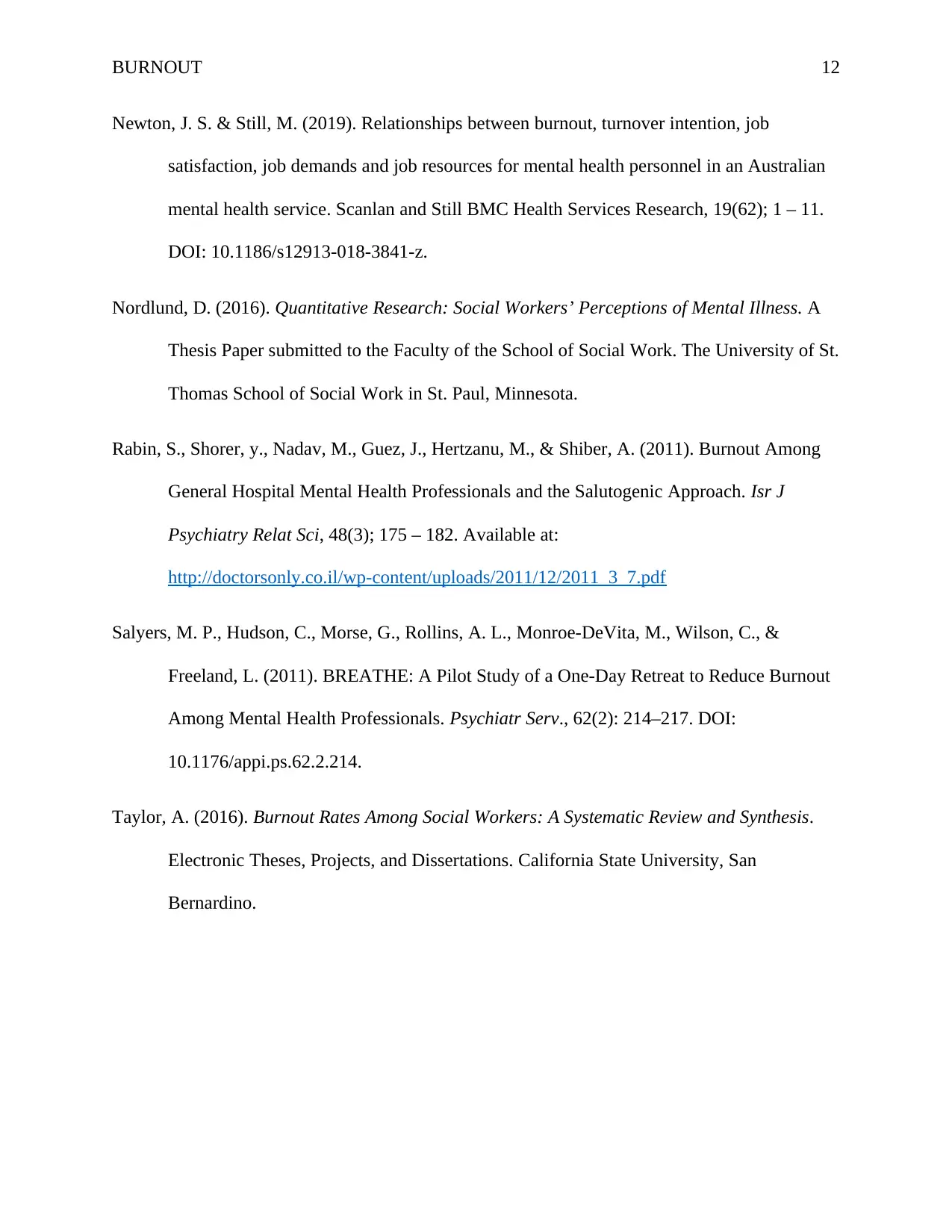
BURNOUT 12
Newton, J. S. & Still, M. (2019). Relationships between burnout, turnover intention, job
satisfaction, job demands and job resources for mental health personnel in an Australian
mental health service. Scanlan and Still BMC Health Services Research, 19(62); 1 – 11.
DOI: 10.1186/s12913-018-3841-z.
Nordlund, D. (2016). Quantitative Research: Social Workers’ Perceptions of Mental Illness. A
Thesis Paper submitted to the Faculty of the School of Social Work. The University of St.
Thomas School of Social Work in St. Paul, Minnesota.
Rabin, S., Shorer, y., Nadav, M., Guez, J., Hertzanu, M., & Shiber, A. (2011). Burnout Among
General Hospital Mental Health Professionals and the Salutogenic Approach. Isr J
Psychiatry Relat Sci, 48(3); 175 – 182. Available at:
http://doctorsonly.co.il/wp-content/uploads/2011/12/2011_3_7.pdf
Salyers, M. P., Hudson, C., Morse, G., Rollins, A. L., Monroe-DeVita, M., Wilson, C., &
Freeland, L. (2011). BREATHE: A Pilot Study of a One-Day Retreat to Reduce Burnout
Among Mental Health Professionals. Psychiatr Serv., 62(2): 214–217. DOI:
10.1176/appi.ps.62.2.214.
Taylor, A. (2016). Burnout Rates Among Social Workers: A Systematic Review and Synthesis.
Electronic Theses, Projects, and Dissertations. California State University, San
Bernardino.
Newton, J. S. & Still, M. (2019). Relationships between burnout, turnover intention, job
satisfaction, job demands and job resources for mental health personnel in an Australian
mental health service. Scanlan and Still BMC Health Services Research, 19(62); 1 – 11.
DOI: 10.1186/s12913-018-3841-z.
Nordlund, D. (2016). Quantitative Research: Social Workers’ Perceptions of Mental Illness. A
Thesis Paper submitted to the Faculty of the School of Social Work. The University of St.
Thomas School of Social Work in St. Paul, Minnesota.
Rabin, S., Shorer, y., Nadav, M., Guez, J., Hertzanu, M., & Shiber, A. (2011). Burnout Among
General Hospital Mental Health Professionals and the Salutogenic Approach. Isr J
Psychiatry Relat Sci, 48(3); 175 – 182. Available at:
http://doctorsonly.co.il/wp-content/uploads/2011/12/2011_3_7.pdf
Salyers, M. P., Hudson, C., Morse, G., Rollins, A. L., Monroe-DeVita, M., Wilson, C., &
Freeland, L. (2011). BREATHE: A Pilot Study of a One-Day Retreat to Reduce Burnout
Among Mental Health Professionals. Psychiatr Serv., 62(2): 214–217. DOI:
10.1176/appi.ps.62.2.214.
Taylor, A. (2016). Burnout Rates Among Social Workers: A Systematic Review and Synthesis.
Electronic Theses, Projects, and Dissertations. California State University, San
Bernardino.
⊘ This is a preview!⊘
Do you want full access?
Subscribe today to unlock all pages.

Trusted by 1+ million students worldwide
1 out of 12
Related Documents
Your All-in-One AI-Powered Toolkit for Academic Success.
+13062052269
info@desklib.com
Available 24*7 on WhatsApp / Email
![[object Object]](/_next/static/media/star-bottom.7253800d.svg)
Unlock your academic potential
Copyright © 2020–2025 A2Z Services. All Rights Reserved. Developed and managed by ZUCOL.





